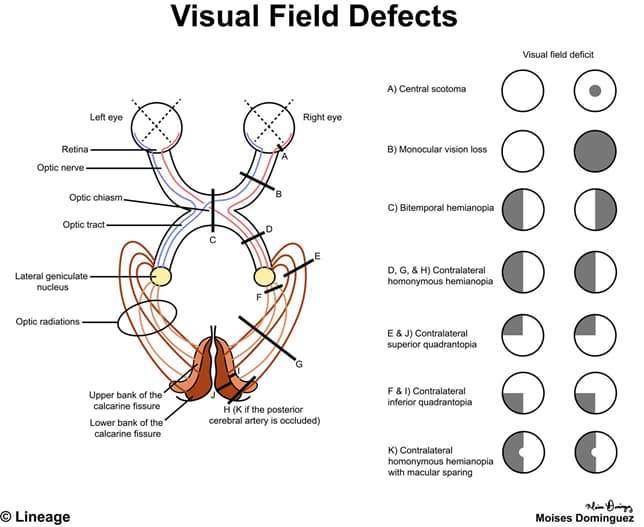Overview

Introduction
- When light passes through the lens it reaches the
- the retina, where the formed image is
- inverted and reversed
- for example, upper visual space information will be projected to the lower retina
- inverted and reversed
- axons leave the retina into the optic nerve
- fibers pass through the optic chiasm and subsequently in the optic tract
- there is fiber crossing in the optic chiasm
- neuronal fibers from the left side of the retina (left hemi-retina) will end up in the
- left optic tract
- neuronal fibers from the right hemi-retina will end up in the
- right optic tract
- neuronal fibers from the left side of the retina (left hemi-retina) will end up in the
- there is fiber crossing in the optic chiasm
- fibers pass through the optic chiasm and subsequently in the optic tract
- axons in the optic tracts will synapse in the lateral geniculate nucleus (LGN) of the thalamus
- fibers from the LGN makes it way to the visual cortex as optic radiations
- inferior optic radiations form the Meyer’s loop
- which carries information from the inferior retina (and thus the superior visual field)
- note that these radiations pass into the temporal lobe and therefore
- temporal lobe lesion result in a
- contralateral homonymous superior quadrantopia (“pie in the sky”)
- temporal lobe lesion result in a
- superior optic radiations pass by the parietal lobe and therefore
- lesions of the parietal lobe results in a
- contralateral homonymous inferior quadrantopia (“pie on the floor”)
- lesions of the parietal lobe results in a
- inferior optic radiations form the Meyer’s loop
- fibers from the LGN makes it way to the visual cortex as optic radiations
- optic radiations eventually synapse in the primary visual cortex
- superior optic radiations project to the
- superior bank of the calcarine fissure
- inferior optic radiations will project to the
- lower bank of the calcarine fissure
- superior optic radiations project to the
- the retina, where the formed image is
- Summary of conscious vision perception
- Additional pathways
- retina → optic nerve → optic chiasm → optic tract → pretectal area and superior colliculus
- the pretectal area is important for the
- pupillary light reflex
- swinging flashlight test is used to diagnose a relative afferent pupillary defect
- normal
- both pupils constrict quickly and equally when either is exposed to direct light
- pupils do not change in size when light moves quickly between eyes
- abnormal (lesion in the afferent pathway)
- sensory stimulus from affected pathway to the midbrain is reduced
- unaffected pupil will dilate from its constricted state when light is moved from the unaffected to the affected eye
- common causes include unilateral optic nerve lesions and severe unilateral retinal disease
- normal
- swinging flashlight test is used to diagnose a relative afferent pupillary defect
- pupillary light reflex
- the superior collicus and pretectal area is important for
- eye movement towards visual stimuli
- the pretectal area is important for the
- retina → optic nerve → optic chiasm → optic tract → pretectal area and superior colliculus
Common Lesions



